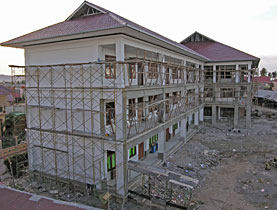Work continues three years after tsunami

Aid organisations in Switzerland say good progress has been made since a huge tidal wave devastated parts of southeast Asia three years ago.
Reconstruction after the tsunami – with the exception of northern Sri Lanka – is continuing and livelihood programmes have been implemented. But experts say the trauma of the catastrophe still remains.
The wave struck on December 26, 2004, following an underwater earthquake near the Indonesian island of Sumatra. It caused the deaths of an estimated 226,000 people and injured 125,000 others.
Many Swiss agencies and non-governmental organisations have been involved in efforts to rebuild the affected areas.
The Swiss Agency for Development and Cooperation (SDC) says it has spent SFr35 million ($30 million) mainly in Sri Lanka, Thailand and Indonesia, which were among the worst affected countries. Most of its reconstruction programmes are now drawing to a close.
On Sunday it made public the findings of two external audits on school rebuilding projects in Sri Lanka, which had been commissioned following negative media reports.
Both confirmed good progress and a high standard of quality, said the SDC on its website.
For its part, Swiss Solidarity – a foundation led by swissinfo’s parent body, the Swiss Broadcasting Corporation – said its assessment of tsunami relief three years on was “very positive”.
More than SFr204 million – in total SFr227 million was collected – had been used for house building projects, caring for children and support for communities, it said.
The balance has been earmarked for sustainable follow-up programmes.
Far-reaching projects
The Geneva-based humanitarian agency the International Federation of Red Cross and Red Crescent Societies said in its latest tsunami work report that it had used two thirds of the SFr3 billion of the funds it had collected.
“We are fairly much online having reached 3.8 million people in ten affected countries at this stage with new houses and better water, health and sanitation facilities,” Jerry Talbot, the Federation’s special representative for tsunami recovery, told swissinfo.
“There’s still more work to be done but by the end of five years we should more or less have completed the recovery programme,” he added.
The NGO Swiss Labour Assistance (SLA) has also been rebuilding infrastructure, in India and Sri Lanka.
Like the Red Cross and Red Crescent Federation, it has livelihood support programmes, such as gardening, aimed at helping people earn an income.
Problematic areas
However, there have also been problems. Both Talbot and Swiss Solidarity point to legal issues over land which have held up some projects.
The flare up of violence in the north of Sri Lanka has also taken its toll. According to Barbara Gruner, the SLA’s head of humanitarian aid, the SLA had to stop most of its infrastructure programmes in the area last year.
“We’re still constructing shelters and have relief programmes there but this has really shifted from tsunami-affected to tsunami and civil war-affected,” Gruner told swissinfo.
Swiss humanitarian work has also centred on dealing with trauma as experts say memories of the tsunami are still fresh.
“On the one hand there is some hope and new lives for many people, but on the other hand, I believe people will probably need more than one generation to forget about the catastrophe,” Gruner said.
Talbot agrees, highlighting how during his work in the Maldives – where an estimated one third of the population was badly affected by the tidal wave – people have reacted very emotionally to new tsunami warnings.
Disaster risk reduction through safer structures and education is therefore of utmost importance.
“For us it is key that not only people’s livelihoods are restored but in the end people feel safer and are able to live in safe environment,” Talbot said.
swissinfo, Isobel Leybold-Johnson
The tsunami struck on December 26, 2004 after a seaquake of around 9 on the Richter scale, with an epicentre off the Indonesian island of Sumatra.
It caused the deaths of an estimated 226,000 people and injured 125,000 others.
Worst affected was the Indonesian province of Aceh. Also severely affected was Sri Lanka, Thailand, parts of southeast India and the Maldives.

In compliance with the JTI standards
More: SWI swissinfo.ch certified by the Journalism Trust Initiative












You can find an overview of ongoing debates with our journalists here . Please join us!
If you want to start a conversation about a topic raised in this article or want to report factual errors, email us at english@swissinfo.ch.